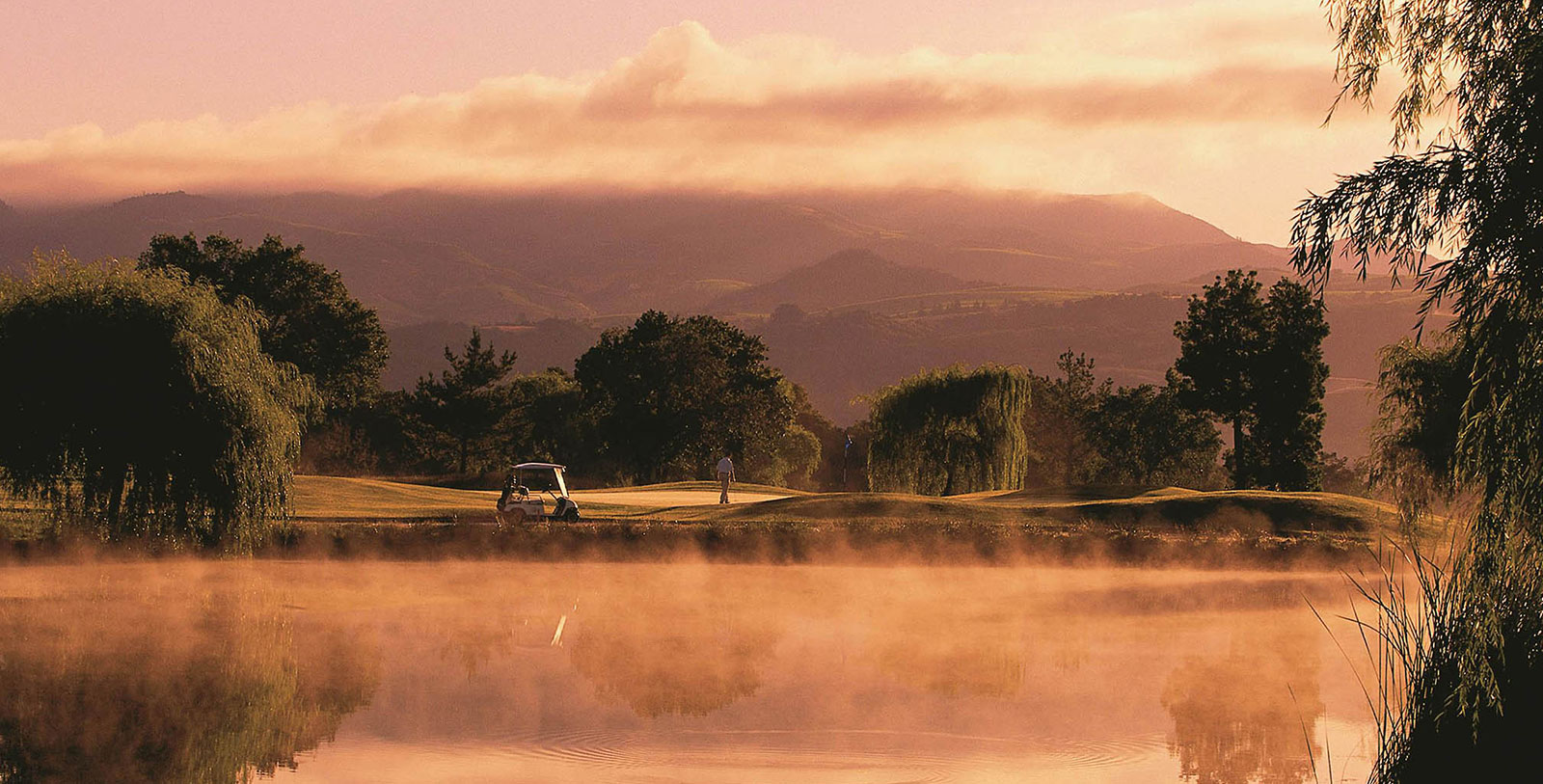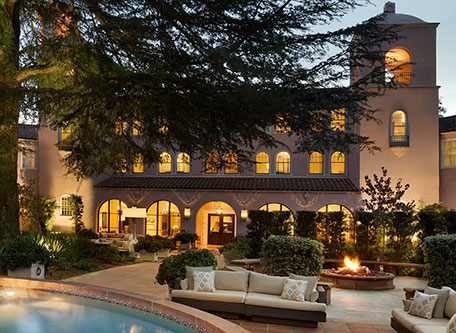Receive for Free - Discover & Explore eNewsletter monthly with advance notice of special offers, packages, and insider savings from 10% - 30% off Best Available Rates at selected hotels.
sonoma golf club
Discover the affiliated Sonoma Golf Club’s 18-hole golf course, which was originally developed by esteemed landscape architect Sam Whiting.
Fairmont Sonoma Mission Inn & Spa’s and Sonoma Golf Club's partnership dates back to 1928.
VIEW TIMELINEThe Sonoma Golf Club is designed by golf course architect Sam Whiting in 1928, the affiliated Sonoma Golf Club’s golf course is located less than a mile from Fairmont Sonoma Mission Inn & Spa. Whiting was an architect from the “Golden Age” of golf course architecture and built courses throughout California. He specifically crafted the future Sonoma Golf Club Golf Course out of some 77 acres that had once belonged to a historic ranch owned by J.K. Bigelow. Its construction was the final phase of the larger project that created Fairmont Sonoma Mission Inn & Spa, which had been organized by entrepreneurs Fred Partridge and Rudolph Lichtenberg. Nevertheless, the course is one of several he designed that are still playable in the present. The club today describes the 7,103-yard course as a fair but formidable test, with unique challenges designed to keep players focused. There is a distinctive set of par-threes that offer a great variety of aesthetic beauty and personal challenges. Three of them are over 200 yards from the back tees. The back nine offers reachable par-five holes 13 and 16. The elevated hole 11 is a fun, short par-four that is followed by another par-four hole known for its difficulty to stick in two. The finishing hole demands that players navigate a stretched dogleg with a prominent fairway bunker to a green guarded by huge oaks and a small creek.
The golf course at Fairmont Sonoma Mission Inn & Spa has remained true to the tenets of the game since its debut at the height of the Roaring Twenties. Its classic layout continues to strategically challenge golfers in an exciting and enjoyable format. Over the years, many famous golfers have tested their skills against Whiting’s venerable design at Sonoma, too. Among them were Sam Snead, Byron Nelson, Ken Venturi, and Tom Watson. Most of those golfers have specifically played in the exciting Charles Schwab Cup Championship—the prestigious event that concludes the PGA Tour Championships. Indeed, the golf course hosted the celebrated event for several years from 2003 to 2009. (The tournament moved to another Whiting-designed golf course, the TPC Harding Park, the following year.) The golf club itself offers players a mission style clubhouse, with architecture that reflects the Spanish heritage of the Valley. The building also echoes a considerable number of the area’s historic structures, including Fairmont Sonoma Mission Inn & Spa. The interior exudes a warm atmosphere with its wooden beamed ceilings, Mission-style furnishings, and open floorplan. Golfers are invited to relax on one of the exterior patios, which offer uninterrupted views of the course and the Mayacamas Mountains.
Guests of Fairmont Sonoma Mission Inn & Spa are granted exclusive access to this renowned members-only golf course during their stay, including the Sonoma Golf Shop and Clubhouse Grill Restaurant.
-
About the Location +
Fairmont Sonoma Mission Inn & Spa resides within the neighborhood of Boyes Hot Springs, a district of Sonoma that was once its own independent settlement. Sonoma itself is one of California’s most historic communities, having been established at the site of the Mission San Francisco Solano in 1835. It was specifically founded as a military outpost by Mexican military officer Mariano Guadalupe Vallejo, who had been sent north to investigate Russian explorations in the region. Mission San Francisco Solano itself dated back a decade prior, created as the last—and most northern—of the 21 Franciscan missions in California. Father Jose Altimira presided over the site, governing it until its closure by the Mexican government in 1833. Eventually, Mariano Guadalupe Vallejo transformed the mission into a fortress, which he would use as a deterrent against any further foreign encroachments into the Bay Area. More importantly, Vallejo’s new base would provide much needed military support for the El Presidio Real de San Francisco, which was the main Mexican military installation in central California. The central component of the base was the Sonoma Barracks, which served as the headquarters for the entire garrison. Soon enough, a small village soon emerged around the new fort, with the Sonoma Plaza serving as its center. Vallejo eventually named the new town, “Pueblo de Sonoma.” Historians today believe Vallejo discovered the name “Sonoma” from a local tribe of Native Americans, perhaps a band of the Wintun.
Pueblo de Sonoma continued to support the El Presidio Real de San Francisco right up until 1846, when American settlers occupied the Sonoma Plaza. Led by Captain John Charles Frémont, the group seized the fort and held its garrison captive amid the Mexican-American War. They declared the town the capital of their new country—the Republic of California—and raised the “Bear Flag” high above the base. (Interestingly, the flag was originally designed by William Todd, who was the nephew of future First Lady Mary Todd Lincoln.) The republic did not last long though, as the rebels soon surrendered control over their outpost to the United States, which had invaded the nearby port city of Monterey. As such, the enclave became a territory ruled by the United States, although it lost its status as a center for regional governance. It did continue to house soldiers inside the Sonoma Barracks, including a company of U.S. Marines and Army dragoons. Major General Persifor Smith also used the barracks as the main administrative office for the newly created Pacific Division—a distinction that it kept for the next six years. But Sonoma eventually lost its position as a military installation once the nearby town of Benicia opened its own facilities in the early 1850s.
A strong civilian economy emerged as Sonoma transited away from being a military base. Miners were still traveling to the region in the wake of the California Gold Rush, with many flocking to Sonoma to pick up supplies. Some prospectors even believed that the area surrounding the town was ripe for gold mining, which led to rampant land speculation. As such, Sonoma quickly underwent a population boom that saw its size grow exponentially. It also began to cultivate a local tourism industry that produced dozens of hotels across town. Interest in visiting Sonoma remained, even after the gold mining craze had long died out. It was within this environment that Captain Henry E. Boyes was able to build his celebrated health resort. Around the same time, a Hungarian count named Agoston Haraszthy arrived in Sonoma. Purchasing hundreds of acres to the east of the town, he constructed a magnificent estate called “Buena Vista.” Haraszthy then proceeded to plant thousands of European grape vines throughout the property, creating the first modern vineyard in the area. Buena Vista built the foundation for the current California wine industry and transformed the entire Sonoma Valley into America’s premier wine growing region. Today, Sonoma is one of the most visited places in central California. It is home to the renowned Sonoma International Film Festival, as well as few of the finest wineries in the nation. Sonoma also contains several reputed historic sites, including the Sonoma Plaza, which the U.S. Department of the Interior has recognized as a National Historic Landmark.
-
About the Architect +
Sam Whiting: The man responsible for creating the Sonoma Golf Club’s magnificent fairways was Sam Whiting, an English golfer who frequently dabbled in landscape design throughout his career. Whiting originally hailed from a family of established golfers, with six of his seven brothers going on to compete professionally. In fact, three generations of Whitings worked as the main club professional at The Royal St. George’s Golf Club. Whiting himself got his start in the sport working as an apprentice to J.H. Taylor, an accomplished competitor who had won the British Open five different times. Under Taylor’s tutelage at the Royal Mid-Surrey Golf Club, Whiting managed to pick up the finer points of golf rather quickly. But he also gained valuable lessons in landscape design from the club’s main greenskeeper, Peter Lees. Whiting thus managed to parlay the experience to get a job with the Ilkley Golf Club once his training had ended several years later in 1911. He then provided a wealth of services to the many members of the club that ranged from instructional classes to equipment maintenance.
During his time as club professional, he began giving lessons to a prominent American academic and political activist named Robert Hunter. Impressed with his skill, Hunter eventually asked Whiting to help him construct his own compound—the Berkeley Country Club—across the bay from San Francisco. Whiting eagerly accepted the position and began aiding in its development in 1921. However, Whiting did not exercise any independent control over the design, deferring instead to Hunter and his lead architect, William Watson. Whiting nonetheless continued to help create the Berkeley Country Club until he was forced to leave when a labor strike caused a work stoppage. He soon found a new position developing The Olympic Club alongside Watson two years later, specifically its Lake and Ocean Courses. When The Olympic Club finally opened in 1924, it earned significant praise. Whiting subsequently took over as the club professional—a role that he maintained diligently over the next three decades. But despite his repute as the club’s head golfer, other institutions succeeded in coaxing him to periodically construct courses for them. Among the best surviving examples of his work include TPC Harding Park, Stockton Golf & Country Club, and, of course, Sonoma Golf Club.
-
Famous Historic Golfers +
Sam Snead, winner of seven major golf championships that include the PGA of America and Senior PGA Tour.
Byron Nelson, winner of five major golf championships that include the Masters Tournament, the PGA Championship, and the U.S. Open.
Ken Venturi, winner of one major championship—the 1964 U.S. Open.
Tom Watson, winner of eight major golf championships that include the Masters Tournament, U.S. Open, and the British Open.


































